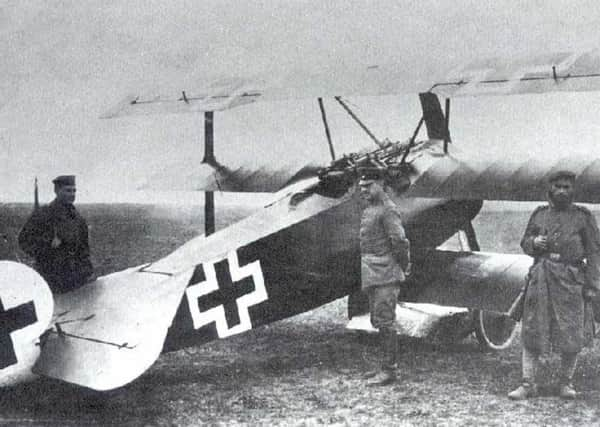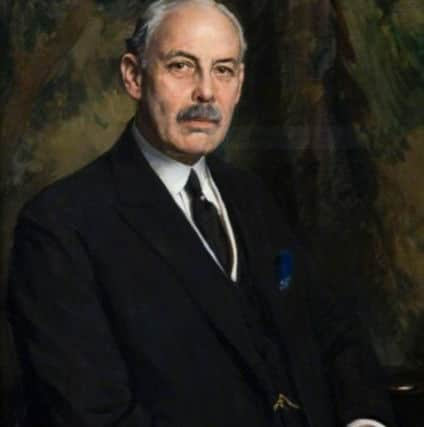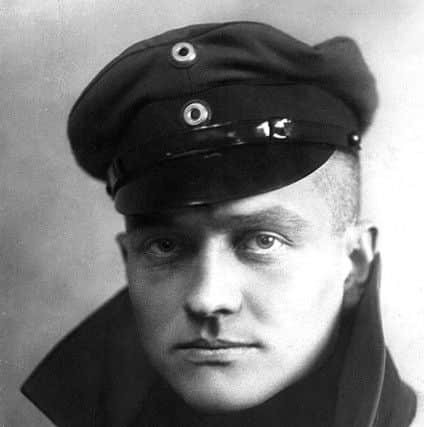Belfast surgeon was amongst the first to examine the body of the iconic Red Baron


Punctuated with spluttered ‘engine noises’ from our pursed lips, these were our very unconvincing impersonations of the Red Baron, the famous First World War German fighter pilot.
For us it was a game, but no name struck more fear into the hearts of Allied airmen during the Great War than that of Baron Manfred von Richthofen.
Advertisement
Hide AdAdvertisement
Hide AdAfter scoring his first kill on September 17th 1916, the German pilot spent the next 19 months prowling the skies in his signature red airplane, winning one air battle after another.


He was later shot down and killed in April 1918, but not before he became First World War’s highest-scoring fighter ace.
I was reminded of my air-fighting fantasies on the playground by a recent note in Roamer’s mailbox which began: “A long serving Queen’s University Professor of Medicine solved a major dispute about the death of the famous and deadliest German fighter pilot, the Red Baron.”
The note referred to several authoritative war historians’ accounts and to a biography on the Remembrance NI website (remembranceni.org) of Thomas Sinclair, Professor of Medicine at Queen’s University Belfast, who was an army surgeon during First World War.
Advertisement
Hide AdAdvertisement
Hide AdProfessor Thomas Sinclair had an outstanding record in his profession.


He was educated privately and intended to go into business.
However, in 1877 he entered Queen’s College, then a constituent college of the Royal University of Ireland, where he graduated with first-class honours in 1881, winning an exhibition prize in 1880 and a gold medal in 1881.
He then worked at the London Hospital, in Vienna, and in Berlin, acting for a time as demonstrator of anatomy at Queen’s College, Belfast.
Advertisement
Hide AdAdvertisement
Hide AdHe became a member of the Royal College of Surgeons in 1882 and a Fellow in 1886.
His first hospital appointment in Belfast was on the surgical staff of the Ulster Hospital for Children and Women, where he was ultimately Consulting Surgeon.
In 1885 he was elected Assistant Surgeon to the Royal (later the Royal Victoria) Hospital, becoming surgeon in 1898 and consulting surgeon in 1923.
He was also consulting surgeon to the Forster Green Hospital, the Co Antrim Infirmary, and the Lisburn and Coleraine Cottage Hospitals.
Advertisement
Hide AdAdvertisement
Hide AdIn 1886, at the age of 29, he became Professor of Surgery at Queen’s College and held the post for 37 years, retiring at the age limit in 1923.
He is said to have taught more than 2,000 medical students.
Commissioned in November 1915, Professor Sinclair was consulting surgeon to the 4th Army during First World War, under General Rawlinson in France and later under Field Marshal Allenby in Egypt, with the rank of Colonel in the Army Medical Service.
By then Baron Manfred von Richthofen was the terror of the skies.
Advertisement
Hide AdAdvertisement
Hide AdDuring a 19-month period between 1916 and 1918, the Red Baron shot down over 80 Allied aircraft and won widespread fame for his scarlet-coloured airplanes and ruthlessly-effective flying style.
Richthofen’s legend grew after he took command of a German fighter squadron known as the Flying Circus, but his career in the cockpit was cut short on 21 April 1918 when he was killed in an aerial dogfight over France.
During an exchange of fire, Richthofen was struck in the torso by a bullet and died after crash-landing in a field.
Debate has continued over whether an Australian infantryman on the ground fired the fatal shot, as Richthofen had been flying at a very low level directly over the front line and had been fired on by Australian anti-aircraft machine gunners as well as by many Australian soldiers.
Advertisement
Hide AdAdvertisement
Hide AdBut Professor Thomas Sinclair was amongst the first doctors who examined the body of Richthofen, and the professor, then a colonel, reported on the first, superficial post mortem.
On April 22nd 1918, he wrote “there are only the entrance and exit wounds of one rifle bullet on the trunk. The entrance wound is on the right side about the level of the ninth-rib, which is fractured, just in front of the posterior axillary line.
“The bullet appears to have passed obliquely backwards through the chest striking the spinal column, from which it glanced in a forward direction and issued on the left side of the chest, at a level about two inches higher than its entrance on the right and about in the anterior axillary line.
“There was also a compound fracture of the lower jaw on the left side, apparently not caused by a missile – and also some minor bruises of the head and face.”
Advertisement
Hide AdAdvertisement
Hide AdThere have been numerous publications debating whether the Red Baron’s fatal shot came from ground or air, with some of the relevant bibliography included on the Remembrance NI website.
After the war Professor Sinclair returned to Belfast and occupied himself particularly with the affairs of the Queen’s University, as Queen’s College had become in 1908.
He was a generous contributor to the university, as well as to the hospitals with which he was connected.
He died in Belfast after several months’ illness on November 25th 1940.
Advertisement
Hide AdAdvertisement
Hide AdA great teacher and a wise administrator, he held a unique place in the professional and academic life of Belfast for more than a quarter of a century.
A portrait, presented in his honour in 1931, hangs in the Great Hall of QUB.